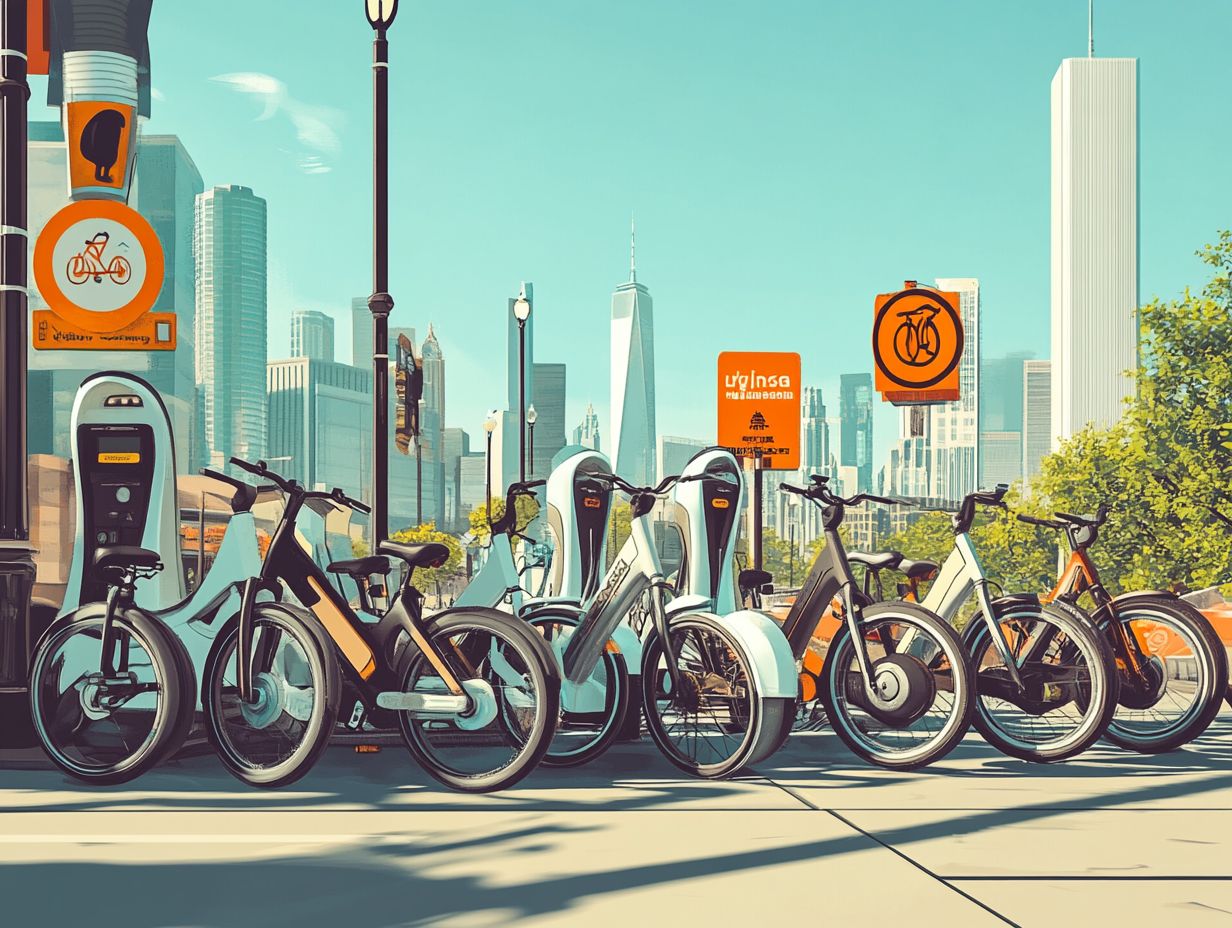Electric Bicycle Laws: How They Vary by Region
Electric bicycles are revolutionizing your daily commute. Understanding e-bike laws that regulate their use can be somewhat perplexing.
As you delve into what constitutes an electric bicycle, you ll discover that e-bike regulations can vary significantly from one state to another in the U.S. and even across different countries.
This article will clarify common restrictions on electric bicycles, such as e-bike speed limits, while providing essential safety tips to promote responsible riding.
Let s dive into the world of e-bike laws together!
Contents
- Key Takeaways:
- Overview of Electric Bicycle Laws
- State and Local Laws in the United States
- International Electric Bicycle Laws
- Common Restrictions on Electric Bicycles
- Safety Considerations for Electric Bicycles
- Frequently Asked Questions
- 1. What are electric bicycle laws and how do they vary by region, such as in Portland, Oregon?
- 2. Do all regions have laws specifically for electric bicycles?
- 3. Are there age restrictions for riding an electric bicycle?
- 4. Are there speed limits for electric bicycles?
- 5. Do I need a license to ride an electric bicycle?
- 6. What are the safety regulations for electric bicycles?
Key Takeaways:

Overview of Electric Bicycle Laws
Electric bicycles, often called e-bikes, are transforming how you commute and enjoy leisure activities. They offer a highly efficient alternative to traditional cycling, opening the door to programs like bike sharing.
As e-bikes gain traction, it’s essential for you to grasp the various state laws and regulations surrounding them, whether you’re a rider or a policymaker. Familiarizing yourself with the top 5 electric bicycle laws can help, as these regulations can differ significantly across states and municipalities.
The regulations affect everything from how e-bikes are classified to the maximum speed that is permissible. PeopleForBikes supports clear e-bike laws for everyone, promoting cycling as a sustainable transportation choice while ensuring the safety of all road users, especially in places like Portland, Oregon.
This overview will delve into the critical aspects of electric bicycle laws, their significance, and the current trends shaping e-bike regulations, including the impact of the Child Bicycle Safety Act.
What are Electric Bicycles?
Electric bicycles, or e-bikes, are essentially your ticket to a sustainable and efficient mode of transportation. They feature an electric motor that assists you as you pedal, including options like electric mountain bikes.
You ll discover a variety of e-bikes on the market, including pedal-assist models that help you pedal more easily and throttle-controlled versions that give you a quick boost with just a push of a button.
At the core of these bicycles lies modern electric motor systems, typically categorized into hub motors and mid-drive motors. These components are crucial for performance, enhancing your overall cycling experience.
With electric assist, you can tackle steep hills, commute longer distances with ease, and significantly reduce fatigue.
To keep your e-bike in peak condition, resources on regular battery care, tire inflation, and chain maintenance can greatly extend its lifespan, enhancing your experience with e-bike resources available online.
You re encouraged to explore comprehensive guides and tutorials that offer essential tips on how to use and maintain your bike effectively.
State and Local Laws in the United States
State and local laws governing electric bicycles in the United States can vary widely. These laws shape how you, as an e-bike rider, engage with public lands and transportation systems.
These laws encompass everything from e-bike classification, which distinguishes different types of electric bicycles, to regulations surrounding maximum speed and motor wattage. For detailed information, you can refer to state-specific electric bicycle legal frameworks. All are designed to foster a safe and harmonious environment for both cyclists and pedestrians.
By understanding the specific laws in your state, including the e-bike incentive programs available to you, you can access a range of incentives for e-bikes. This makes it easier for you to embrace this eco-friendly mode of transport.
As cycling communities push for clearer e-bike regulations, it s crucial for you to stay informed about the evolving landscape of e-bike laws across various states.
Stay informed and check your local laws today to ride responsibly and enjoy your e-bike!
Understanding Differences Across States

The differences in e-bike regulations across states can be quite pronounced. They impact everything from how e-bikes are classified to where you can ride them.
Take California, for example. Its laws categorize e-bikes into three distinct classes: Class 1 electric bicycles, Class 2 electric bicycles, and Class 3 electric bicycles. These classifications are based on speed and whether they offer pedaling assistance. This directly affects where you can legally operate your bike. For insights on electric bicycle regulations in urban areas, Class 1 e-bikes, which provide pedal assistance and are capped at 20 mph, enjoy the broadest access, including bike paths.
On the flip side, states like New York impose stricter regulations. They require registration for Class 3 e-bikes, which can reach speeds of up to 28 mph. This highlights the diverse nature of state electric bicycle laws.
These variations shape your legal rights as a rider. They allow you to navigate urban areas in specific ways but complicate compliance when traveling between states. Recent case studies underscore how this lack of uniformity can lead to conflicts between cyclists and law enforcement. It’s crucial to understand state-specific laws and electric bicycle age restrictions by state and the e-bike impact on local communities before you hit the road!
International Electric Bicycle Laws
Understanding international electric bicycle laws provides valuable insights into the diverse ways different countries regulate e-bikes. This has a significant impact on cycling communities, including e-bike policies in North America.
While some nations wholeheartedly embrace electric bicycles as a sustainable transportation solution, others impose stringent regulations. These can stifle adoption and complicate e-bike pilot project efforts.
By examining various e-bike policies across the globe, it becomes evident that the legal framework surrounding e-bikes profoundly influences their growth and acceptance in society. To ensure compliance, it’s important to understand how to stay compliant with electric bicycle laws. These international regulations affect e-bike riders and play a crucial role in shaping public attitudes toward cycling and sustainability. They also impact the potential for different types of transportation working together.
Comparison of Regulations in Different Countries
When you compare regulations surrounding electric bicycles across different countries, you’ll uncover a fascinating and varied landscape of e-bike laws. These laws can significantly impact riders like you, as seen in cities like Birmingham and Park City.
In some nations, legislation promotes e-bikes as a sustainable mode of transportation. This includes initiatives like the Electric Mountain Bike Policy Database, highlighting a broader commitment to environmental responsibility.
Take the Netherlands, for instance. The government has implemented enticing incentives for e-bike purchases through programs like the e-bike lending library. They also have a robust cycling infrastructure. This strategy increased e-bike ownership and helped reduce CO2 emissions.
In the United States, you will find a patchwork of regulations. Some states are leaning towards more lenient laws, allowing for higher speed limits on e-bikes. This fosters greater acceptance of these vehicles. Meanwhile, Germany has embraced the e-bike movement by specifying distinct categories within their traffic laws. This offers clarity on where and how these e-bikes can be used. Such thoughtful regulation paves the way for safer and more structured riding environments for e-bike riders everywhere, as highlighted in the electric bicycle regulations: a global overview.
Common Restrictions on Electric Bicycles
Get ready to discover the common restrictions you might face while riding your e-bike! You will often encounter various rules, such as regulations on e-bike maximum speed, limits on how strong an e-bike’s motor can be, and designated riding areas.
These measures are thoughtfully implemented to enhance e-bike safety and ensure a secure riding experience for everyone involved.
Speed Limitations and Other Limitations

Speed limits for electric bicycles are crucial for e-bike regulations. Many regions have established maximum speed caps to protect both riders and pedestrians, ensuring that e-bike safety remains a priority.
These limits can vary significantly by area, typically restricting e-bikes to speeds between 15 and 28 miles per hour. This can impact how you navigate different cycling communities. For a deeper understanding of the regulations, check out understanding electric bicycle laws in California. Enforcement usually involves a mix of police efforts, public awareness campaigns, and initiatives from organizations like PeopleForBikes, highlighting the importance of responsible riding.
As e-bike usage grows, cities like Portland, Oregon, are increasingly integrating these regulations into broader traffic laws, emphasizing the need for safe coexistence with traditional vehicles.
Adhering to speed limits is vital for e-bike riders. Exceeding these limits can lead to serious accidents, endangering not just the rider but also pedestrians and other road users.
For this reason, compliance with regulations is essential for creating a safer riding environment for everyone in cycling communities.
Safety Considerations for Electric Bicycles
Safety is key when riding your electric bicycle, especially with the growing popularity of e-bikes in cycling communities across diverse regions. Ongoing discussions about e-bike safety policies make this an important topic.
As you embrace this trend, prioritizing e-bike safety becomes paramount to enhance your riding experience and ensure your well-being on the road.
Tips for Riding Safely and Responsibly
To navigate the world of electric bicycles safely and responsibly, it s important for you to follow best practices that elevate both safety and awareness, particularly when riding in public areas.
This includes wearing the right gear such as helmets and reflective clothing to increase visibility, especially in low-light conditions. This ensures higher safety standards for e-bike riders.
Familiarizing yourself with effective riding techniques, like maintaining a steady speed and checking your blind spots (the areas around you that you can t see directly), can significantly reduce the risk of accidents.
Understanding local e-bike laws is also essential. This includes knowing where you can ride on public lands and any speed or power restrictions that apply. For detailed information, consider navigating electric bicycle licensing requirements. This ensures your experience is both lawful and enjoyable.
Engaging with local cycling communities can enrich your journey, allowing you to make connections while gaining invaluable insights and resources. This not only reinforces safe riding habits but also helps you stay updated on the latest regulations and safety tips.
Frequently Asked Questions
1. What are electric bicycle laws and how do they vary by region, such as in Portland, Oregon?

Electric bicycle laws refer to the regulations surrounding the use of electric bicycles in various parts of the world. These laws can differ by region, meaning that what is allowed in one area may not be permitted in another.
2. Do all regions have laws specifically for electric bicycles?
Yes, most regions have laws that specifically address the use of electric bicycles. However, the specifics of these laws can vary, so it’s important to research your local regulations before riding an electric bicycle.
3. Are there age restrictions for riding an electric bicycle?
Age restrictions for electric bicycles can differ by region. In some areas, there may be no age limit, while in others, riders must meet a certain age requirement to operate an electric bicycle. Always check your local laws to ensure compliance.
4. Are there speed limits for electric bicycles?
Yes, speed limits for electric bicycles can vary by region. In some areas, there may not be a speed limit, while in others, a maximum speed may be enforced. It s crucial to check your local laws to ensure compliance.
5. Do I need a license to ride an electric bicycle?
In most places, you don’t need a driver’s license to ride an electric bicycle. However, some areas have age or speed rules that may require one. Check your local laws to see if you need a license!
6. What are the safety regulations for electric bicycles?
Safety regulations exist for electric bicycles. They often include requirements for lights and reflectors and rules about where you can ride. Make sure to research the laws in your area before hitting the road!




